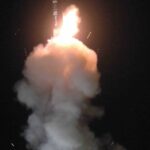
SOURCE: SCMP
As China and India work to resolve their border dispute in the Himalayas, unmanned aerial vehicles (UAVs) are playing an increasingly important role in the dispute. The Indian government said on Wednesday it planned to buy more Heron drones from Israel, while the US Predator B is also on its shopping list, according to Indian media reports.
Meanwhile, China has already widely used UAVs during the months-long stand-off along the Line of Actual Control (LAC), the de facto border between the two countries. Earlier this month, Beijing released images of Indian troop activity in the Galwan Valley – one of the dispute hotspots – which were likely taken by drones.
“Drones can easily access places that are inaccessible for humans, and monitor important sites that are too hard to patrol,” military analyst Zhou Chenming said.“And India has shown it at a disadvantage in both the quality and quantity of its drones.”
Israel Aerospace Industries is the main supplier of UAVs to the Indian Army, with the Heron and Searchers models used for reconnaissance and strikes, and Harpies and Harops used for anti-radiation missions. The Heron is an 8.5-metre (28-foot) long medium-altitude long-endurance (MALE) combat UAV with a payload of up to 250kg (550lbs). It has a top speed of 200km/h (155mph), can operate for up to 52 hours and has a service ceiling – or maximum altitude – of 10,000 metres.
By comparison, the Searcher has a service ceiling of only 6,100 metres, which means its operational scope is limited on the Roof of World. The LAC extends thousands of kilometres along the world’s highest mountains, with an average altitude of over 4,000 metres – some peaks rise beyond 8,000 metres – and is a harsh environment for the drones. India owns about 70 Herons. In 2018, an Indian Heron UAV crossed the LAC near Doklam and crashed on Chinese territory. A year earlier, another Indian drone did the same, though that model was not identified.
The country also has been developing its own MALE attack drones – Rustom and Rustom-II – but neither has entered service.
People’s Liberation Army is the GJ-2 reconnaissance/strike model. No figures are available for how many GJ-2s the PLA has, but China has sold 48 of them to Pakistan under the export brand name, Wing Loong II.
The GJ-2 is an 11-metre long MALE with a payload of 480kg. It can carry up to 12 missiles or bombs, has a top speed of 380km/h, a cruising speed of 200km/h and a service ceiling of 9,000 metres – making it bigger, faster and better armed than the Heron.
Apart from the GJ-2, the PLA is reported to have deployed large reconnaissance/strike drones like the CH-4, which underwent tests in the Tibetan plateau region in 2018, and the BZK-005C – specifically modified for use at high altitudes – which was spotted at Lhasa airport in 2017.
The BZK-005C’s design is optimised for landing on soft soil runways and it has a payload of up to 300kg.
Earlier this year, the UAV took part in a live-fire drill in Tibet, firing different types of guided-bombs and missiles at ground targets, Chinese state media reported at the time.
Apart from these large battle drones, the PLA has UAVs for other purposes.
Footage from state television showed a scout team using a small quadcopter of just 20cm (eight inches) across during a night penetration exercise at high altitude, and artillery brigades employing lightweight drones to detect targets dozens of kilometres away.
The PLA also uses drones to deliver food, medicine and ammunition to positions that are inaccessible to motor vehicles, the reports said.
“For India, the procurement process is slow and the amount [of UAVs it has] is limited. Also, no advanced UAVs are cheap – except the Chinese ones – so I don’t see them overpowering China on the border in terms of drones,” Zhou said.






